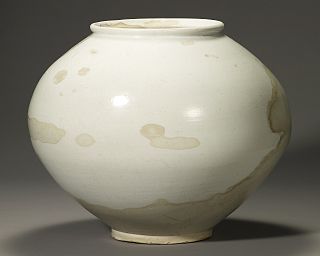 W
WKorean ceramic history begins with the oldest earthenware dating to around 8000 BC. Influenced by Chinese ceramics, Korean pottery developed a distinct style of its own, with its own shapes, such as the moon jar or maebyeong version of the Chinese meiping vase, and later styles of painted decoration. Korean ceramic trends had an influence on Japanese pottery and porcelain. Examples of classic Korean wares are the celadons of the Goryeo dynasty (918–1392) and the white porcelains of the Joseon dynasty (1392–1897).
 W
WBuncheong ware, or Punch'ong, is a form of traditional Korean stoneware, with a bluish-green tone. Pots are coated with a white slip, and decorative designs are painted on using an iron pigment. The style of stoneware arose in the 14th century and continues today.
 W
WCeladon is a term for pottery denoting both wares glazed in the jade green celadon color, also known as greenware, and a type of transparent glaze, often with small cracks, that was first used on greenware, but later used on other porcelains. Celadon originated in China, though the term is purely European, and notable kilns such as the Longquan kiln in Zhejiang province are renowned for their celadon glazes. Celadon production later spread to other parts of East Asia, such as Japan and Korea as well as Southeast Asian countries such as Thailand. Eventually, European potteries produced some pieces, but it was never a major element there. Finer pieces are in porcelain, but both the color and the glaze can be produced in stoneware and earthenware. Most of the earlier Longquan celadon is on the border of stoneware and porcelain, meeting the Chinese but not the European definitions of porcelain.
 W
WA dragon jar, also known as cloud-dragon jar, is a type of ceremonial porcelain vessel that became popular among the ruling classes of Korea during the Joseon Dynasty (1392–1910). They are decorated with large dragons against a background of stylized clouds, painted with underglaze pigments.
 W
WGoryeo ware refers to all types of Korean pottery and porcelain produced during the Goryeo dynasty, from 918 to 1392, but most often refers to celadon (greenware).
 W
WIcheon Ceramic Festival is a South Korean festival opened every year in Gyeonggi-do province.
 W
WJangdokdae or Jangttokttae is an outside space, most frequently a terrace, where a series of jars are gathered.
 W
WJoseon white porcelain or Joseon baekja refers to the white porcelains produced during the Joseon dynasty (1392-1910).
 W
WThe Koryo Museum of Art opened in Kyoto, Japan, in 1988. The collection amassed by the Museum's founder, pachinko magnate and izakaya operator Jeong Jo-mun (鄭詔文), comprises some 1,700 objects including Goryeo celadons, Joseon white porcelain, Buddhist art, Korean folk art, archaeological materials, and paintings, including Heron by Kim Myeong-guk with an inscription by Hayashi Razan.
 W
WMaebyeong refers to Korean vessels with a small slightly curled mouth rim, short neck, round shoulder, and constricted waist. The maebyong is derived from the Chinese meiping. They were first used to hold wine and later branches of plum blossoms.
 W
WMoon jar is a type of traditional Korean white porcelain which was made during the Joseon dynasty (1392–1910). The Joseon white porcelain was adopted as imperial ware in the fifteenth century. The name comes from its shape and milky color of the glaze to resemble the coloration of the moon
 W
WOnggi is Korean earthenware, which is extensively used as tableware, as well as storage containers in Korea. It includes both unglazed earthenware fired near 600 to 700°C and pottery with a dark brown glaze fired at over 1100°C.
 W
WA ttukbaegi (뚝배기) is a type of oji-gureut, which is an onggi coated with brown-tone ash glaze. The small, black to brown earthenware vessel is a cookware-cum-serveware used for various jjigae (stew), gukbap, or other boiled dishes in Korean cuisine. As a ttukbaegi retains heat and does not cool off as soon as removed from the stove, stews and soups in ttukbaegi usually arrive at the table at a bubbling boil.